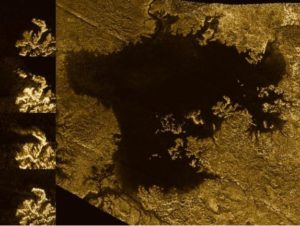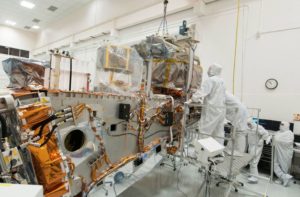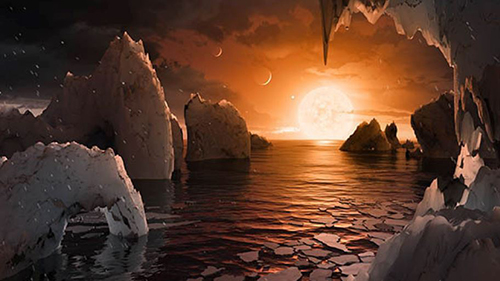
With clouds, rain, seas, lakes and a nitrogen-filled atmosphere, Saturn’s moon Titan appears to be one of the worlds most similar to Earth in the solar system. But it’s still alien; its seas and lakes are full not of water but liquid methane and ethane. At the temperatures and pressures found on Titan’s surface, methane can evaporate and fall back down as rain, just like water on Earth. The methane rain flows into rivers and channels, filling lakes and seas. Nitrogen makes up a larger portion of the atmosphere on Titan than on Earth. The gas also dissolves in methane, just like carbon dioxide in soda. And similar to when you shake an open soda bottle, disturbing a Titan lake can make the nitrogen bubble out. But now it turns out the seas and lakes might be fizzier than previously thought. Researchers at NASA’s Jet Propulsion Laboratory recently experimented with dissolved nitrogen in mixtures of liquid methane and ethane under a variety of temperatures and pressures that would exist on Titan. They measured how different conditions would trigger nitrogen bubbles. A fizzy lake, they found, would be a common sight. On Titan, the liquid methane always contains dissolved nitrogen. So when it rains, a methane-nitrogen solution pours into the seas and lakes, either directly from rain or via stream runoff. But if the lake also contains some ethane—which doesn’t dissolve nitrogen as well as methane does—mixing the liquids will force some of the nitrogen out of solution, and the lake will effervesce. “It will be a big frothy mess,” says Michael Malaska of JPL. “It’s neat because it makes Earth look really boring by comparison.” Bubbles could also arise from a lake that contains more ethane than methane. The two will normally mix, but a less-dense layer of methane with dissolved nitrogen—from a gentle rain, for example–could settle on top of an ethane layer. In this case, any disturbance—even a breeze—could mix the methane with dissolved nitrogen and the ethane below. The nitrogen would become less soluble and bubbles of gas would fizz out.
Heat, the researchers found, can also cause nitrogen to bubble out of solution while cold will coax more nitrogen to dissolve. As the seasons and climate change on Titan, the seas and lakes will inhale and exhale nitrogen. But such warmth-induced bubbles could pose a challenge for future sea-faring spacecraft, which will have an energy source, and thus heat. “You may have this spacecraft sitting there, and it’s just going to be fizzing the whole time,” Malaska says. “That may actually be a problem for stability control or sampling.” Bubbles might also explain the so-called magic islands discovered by NASA’s Cassini spacecraft in the last few years. Radar images revealed island-like features that appear and disappear over time. Scientists still aren’t sure what the islands are, but nitrogen bubbles seem increasingly likely. To know for sure, though, there will have to be a new mission. Cassini is entering its final phase, having finished its last flyby of Titan on April 21. Scientists are already sketching out potential spacecraft—maybe a buoy or even a submarine—to explore Titan’s seas, bubbles and all. To teach kids about the extreme conditions on Titan and other planets and moons, visit the NASA Space Place:
https://spaceplace.nasa.gov/planet-weather/




